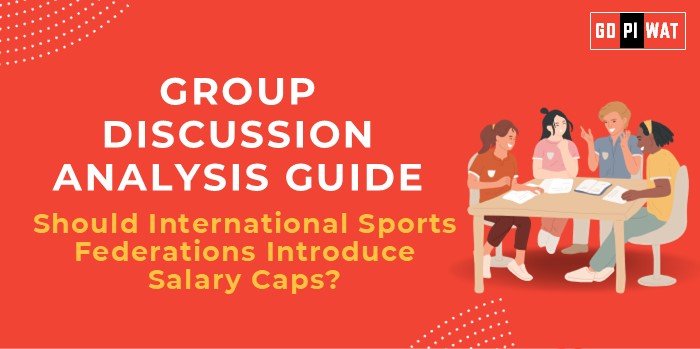📋 Group Discussion (GD) Analysis Guide: Should International Sports Federations Introduce Salary Caps?
🌐 Introduction to the Topic
Opening Context: The idea of salary caps in international sports has sparked debate over its impact on financial equity and competitive balance. It holds particular significance in today’s sports industry, where disparities in player salaries are stark and can affect team performance and league dynamics.
Topic Background: Salary caps are mechanisms to limit the amount teams can spend on player salaries. Originating in North American sports leagues like the NFL and NBA, the concept is now being considered globally to address issues such as financial disparity, team competitiveness, and talent distribution.
📊 Quick Facts and Key Statistics
- 💰 Global Sports Revenue: $620 billion in 2023 – Reflects the financial scope of the sports industry.
- ⚽ Highest Salaries in Football: Lionel Messi, $41 million/year (2023) – Highlights disparity in player earnings.
- 🏈 NFL Salary Cap: $224.8 million per team (2023) – A benchmark for controlled spending.
- 📄 FIFA Report: 20% of football clubs account for 80% of player expenditures (2023).
🤝 Stakeholders and Their Roles
- 🌍 International Federations (e.g., FIFA, ICC): Enforce salary caps and regulate financial practices.
- 💪 Players and Unions: Advocate for fair contracts and oppose restrictions on earnings.
- 🏟️ Team Owners/Clubs: Manage finances and maintain competitive squads.
- 🎉 Fans and Sponsors: Seek quality competition and brand associations.
🏆 Achievements and Challenges
Achievements:
- ✨ Financial Equity: NFL and NBA examples show improved league balance.
- 📉 Cost Control: Ensures smaller teams remain financially viable.
- 🧩 Talent Distribution: Promotes wider talent dispersal across teams.
Challenges:
- ⚖️ Legal and Ethical Concerns: Restraining individual earning potential can be contested in courts.
- 🌎 Implementation Across Borders: Varying tax regimes and labor laws complicate global adoption.
- 🚪 Player Retention: Top talents may migrate to uncapped leagues.
🌍 Global Comparisons
• USA: NFL/NBA salary caps bolster league parity.
• Europe: UEFA’s Financial Fair Play rules highlight alternative financial regulations.
Case Studies:
• Premier League: Clubs like Manchester City face penalties for breaching financial rules.
💬 Structured Arguments for Discussion
- ✔️ Supporting Stance: “Salary caps level the playing field, enhancing competitive balance and league integrity.”
- ❌ Opposing Stance: “Caps restrict market dynamics, deterring the best talent and undermining freedom.”
- ⚖️ Balanced Perspective: “Salary caps, if flexible, can ensure equity without stifling excellence.”
📈 Effective Discussion Approaches
- 📝 Opening Approaches: Quote global data on player salaries to establish context.
- 📊 Highlight disparities in club revenues affecting competitive outcomes.
- 💡 Counter-Argument Handling: Acknowledge potential legal issues but cite successful precedents like the NFL.
🔎 Strategic Analysis of Strengths and Weaknesses
• Strengths: Promotes financial discipline, ensures sustainability.
• Weaknesses: Challenges in standardizing globally.
• Opportunities: Align sports with broader ESG (Environmental, Social, and Governance) goals.
• Threats: Resistance from high-earning players.
🎓 Connecting with B-School Applications
• Real-World Applications: Explore salary caps in operations or sports finance projects.
• Sample Interview Questions:
- 📌 “Should Indian Premier League (IPL) adopt salary caps?”
- 📌 “How do salary caps impact fan engagement?”
• Insights for B-School Students:
- 📊 Analyze financial frameworks in sports.
- 🔍 Research labor market impacts on capped industries.


